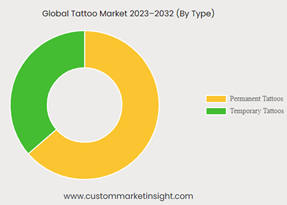PROTECTION OF TATTOOS AS COPYRIGHT WORK IN INDIA
The note discusses protection of tattoos as copyright work in India.
People are fascinated by tattoos for several reasons:
- Self-Expression: Tattoos are a means of self-expression through creativity and originality. They allow individuals to showcase their personality, beliefs, and experiences in a unique and permanent way.
- Cultural Significance: Tattoos have been practiced since prehistoric times in various parts of the world, including India. They often hold cultural and historical significance, representing traditions, rituals, and heritage.
- Influence of Media: The rise in popularity of tattoos can be attributed to increased exposure to global culture, the power of social media, and the success of tattoo reality shows. These platforms have made tattoos more mainstream and acceptable.
- Artistic Appreciation: Many people appreciate the artistic aspect of tattoos. The detailed and intricate designs created by skilled tattoo artists are seen as works of art that can be admired and cherished.
- Personal Stories: Tattoos often tell personal stories and commemorate significant life events. They can serve as reminders of important milestones, loved ones, or personal achievements.
Market size
Global Tattoo Market is anticipated to experience substantial growth from 2023 to 2032. The market is expected to achieve a Compound Annual Growth Rate (CAGR) of approximately 10.80% during this period. In 2023, the market is estimated to be valued at USD 27.10 Billion, and it is projected to reach USD 62.12 Billion by 20321 with Asia Pacific being the fast-growing market. The market share of permanent tattoo is higher than the temporary tattoo.


India’s tattoo industry is growing exponentially and is estimated to generate around Rs. 20,000 crore every year. As tattoos have grown in popularity in the past few decades, it has invited various challenges along with it. One such legal challenge is the right of copyright being applied to said tattoo of the artist.
Are Tattoos protectable under the copyright Act?
The Indian Copyright Act of 1957 did not include clearly the protection of tattoos as a copyrighted work. However, considering tattoos are works of artists; thus, tattoos are protectable under Copyright Law. The Copyright Act of 1957 addresses this by defining artistic work in Section 2(c) of the Copyright Act, It states as follows:-
- a painting, a sculpture, a drawing (including a diagram, map, chart or plan), an engraving or a photograph, whether or not any such work possesses artistic quality
- a [work of architecture]; and
- any other work of artistic craftsmanship;
Tattoos, being permanently inked and drawn onto a person’s skin, are considered as a fixed tangible form of art, qualify for protection under the Act. Section 13(1) of the Copyright Act allows for copyright protection of artistic creations in India, meaning that any tattoo designs which displays originality will be eligible for protection. In India, the Registrar of Copyright gave the copyright to the letter ‘D’ to Shahrukh Khan for his film Don 2 in the year 2011, in his name2. Thus, copyright may be used to protect any tattoo design that shows enough originality, creativity and is printed on physical medium.
Owner of a Tattoo under the Copyright Act
Applying copyright law to tattoos is still a topic of debate. Challenges include determining who owns the copyright—the tattoo artist or the person with the tattoo (bearer of a tattoo)—and deciding the extent of protection against reproduction or alteration by others.
As per Section 17 of the Copyright Act 1957, the author of a work is considered as the first owner of the copyright. Since tattoos are considered an artistic work under the Copyright Act; thus, the tattoo artist is the considered to be the owner of the tattoo and not the tattoo bearer.
However, the person upon whom the tattoo is inked, also known as the tattoo bearer, may acquire the ownership in the copyright in the tattoo in the following ways –
- Contract agreement – The tattoo artist and the tattoo bearer can make an agreement or a contract mentioning who will own the intellectual property linked with the tattoo.
- Relinquishment of copyright – As under Section 21, the copyright owner can relinquish his rights, by filling a notice with the registrar of copyright in the mentioned manner.
- Assignment under section 18 – The copyright owner in an existing work or the prospective owner of the copyright in future work can be assigned to anybody, in whole or in part, according to Section 18 of the Act, as long as the assignment occurs at the time the work is created.
- Granting a license – The owner of the copyright in any existing work or the prospective owner of the copyright in any future work may grant any interest in the right by licence in writing, by him or by his duly authorised agent to person who wishes to use it as a tattoo.
Infringement of a Tattoo
In general, a copyright infringement occurs when the other party uses the art and displays it or uses it through reproduction and distribution without acquiring permission from the actual owner of the copyrighted work. In case of a tattoo created by an artist renowned for crafting exclusive designs legally, that tattoo becomes the artist’s intellectual property. This doesn’t prevent the bearer of tattoo from photographing or displaying its tattoo. However, if the tattoo is used for commercial purposes or in promotions without the artist’s consent, the artist could pursue legal action. In India yet there are no reported cases or disputes relating to copyright infringement of tattoos. Therefore, cases on the subject from US courts may act provide guidance.
- Reed v. Nike or Nike Tattoo Case3 :
- The case involved National Basketball Association (NBA) player Rasheed Wallace and the plaintiff, Matthew Reed.
- Wallace met with Reed to discuss a tattoo that Wallace wanted on his arm. Reed drew up several sketches, and after changes were proposed by Wallace, Reed presented a final sketch that suited Wallace.
- Reed created the tattoo stencil and completed the application of the tattoo to Wallace. There was never any discussion between the two parties regarding copyright ownership over the artwork.
In this case, Mr. Reed a tattoo artist claimed that he was entitled to the rights, title and interest of the original artwork/ tattoo inked on the arm of Mr. Wallace. To obtain relief, Mr. Reed made three claims:
- Mr. Wallace without his permission from Nike and Weiden is subsequently reproducing, copying, distributing, and publicly using the tattoo.
- Contributory infringement against Wallace for making Weiden and Nike believe that Wallace was the exclusive owner of the copyright of the Wallace tattoo.
- Reed was entitled to a percentage of profits obtained by Wallace for the use of his tattoo in the Nike advertisement.
Before the matter could go to trial, the matter was settled out of court.
- S. Victor Whitmill Vs. Warner Bros Entertainment Inc4 or the Mike Tyson’s tattoo case:
Warner Bros was sued by a tattoo artist Victor Whitmill for exploiting the tattoo made by him on Mike Tyson’s face in the movie ‘Hangover II’ without his consent. The tattoo artist had a design registered. The case was finally settled out of court.
- First Copyright Case Decision on Tattoo (https://www.nytimes.com/2024/01/27/arts/kat-von-d-miles-davis-tattoo-copyright-trial.html)
Background
- The case involved a lawsuit brought by Jeffrey Sedlik against Kat Von D, whose legal name is Katherine Von Drachenberg, in 2021 over a free tattoo she created for a friend that used his famous photo of Miles Davis.
- Kat Von D traced a printout of the portrait to create a line drawing and stencil to transfer to her friend’s arm, then completed the tattoo freehand.
- Sedlik sued and moved for summary judgment on his claim of copyright infringement, while the defendants moved for summary judgment, asserting fair use.
Fair Use:
- The court found triable issues as to the transformativeness and commercial nature of the work. The court rejected Kat Von D’s arguments that the tattoo was transformative because of her friend’s personal connection to the image in the portrait and by nature of it being permanently imprinted on her friend’s body.
- The court concluded that a jury should determine whether the visual differences between the portrait and the tattoo, such as additional shading and the elimination of the black background, are significant enough to render the tattoo transformative.
- The court also stated that a jury should decide whether Kat Von D’s use of the work was commercial, noting that she did not charge her friend for the tattoo but could have derived an indirect economic benefit from the promotion of the tattoo on social media.
- The court found that the second factor, the nature of the copyrighted work, favoured fair use because although the portrait is creative, it was published several decades ago and has been widely disseminated.
- The third factor, the amount and substantiality of the portion used, weighed against fair use because Kat Von D chose to copy certain expressive elements of the portrait that were not necessary to achieve her stated purpose of expressing “a sentiment of melancholy”.
- On the fourth factor, the effect of the use upon the potential market for or value of the copyrighted work, the court found that Sedlik raised a triable issue as to whether a future market exists for licensing the Portrait for use in creating tattoos.
Ultimately, the jury found that fair use protected the social media posts of the tattoo and that the tattoo was not substantially similar to Sedlik’s portrait.
Conclusion
With the growing popularity of tattoo culture in India, the need for its explicit protection under the Indian Copyright Act requires urgent attention. While the Indian Copyright Act, 1957 does not include clear copyright protection for tattoos; however, from the above discussions and cases, it appears clear that tattoos are in fact artistic work and copyrightable assets of the tattoo artist, provided it shows originality and is fixed on a tangible medium. Giving artist or creators the exclusive rights to control and profit from the use and distribution of their works is the basic tenet of copyright law. It is important to recognize tattoos as an artistic creation and promote the importance of intellectual property rights in tattoos through Copyright Law. The understanding and overlap of tattoos and copyright with respect to Indian context, will evolve more once cases related to infringement of tattoos will emerge.
2 Agencies, SRK registers Don 2 tattoo in his name, Archive, (Jul. 15, 2011, 11:43 AM)
http://archive.indianexpress.com/news/srk-registers-don-2-tattoo-in-his-name/817871/
https://spicyip.com/2020/07/tattoos-tussle-between-copyright-and-publicity-rights.html
3 https://blog.ipleaders.in/are-tattoos-copyrightable-an-indian-perspective/
4 S. Victor Whitmill Vs. Warner Bros Entertainment Inc, 4:11-CV-752 (2011).



